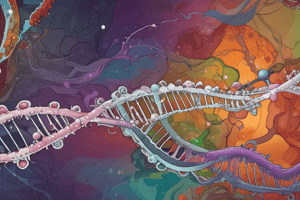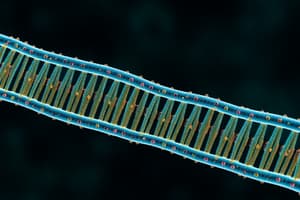Podcast
Questions and Answers
What is the primary role of SR proteins in splicing?
What is the primary role of SR proteins in splicing?
- They mark exons to assist the splicing machinery. (correct)
- They directly splice pre-mRNAs.
- They promote the formation of splice junctions only.
- They bind to introns exclusively.
Which of the following correctly describes Exonic Splicing Enhancers (ESEs)?
Which of the following correctly describes Exonic Splicing Enhancers (ESEs)?
- They inhibit the interaction of SR proteins.
- They are only present in introns.
- They promote splicing at nearby splice junctions. (correct)
- They are found only in untranslated regions (UTRs).
What role does U2AF65 play in splice site recognition?
What role does U2AF65 play in splice site recognition?
- It binds to the polypyrimidine stretch near the 3' splice site. (correct)
- It recognizes the 5' splice site.
- It inhibits the function of U2 snRNP.
- It binds to exon motifs.
How does alternative splicing increase the coding capacity of the genome?
How does alternative splicing increase the coding capacity of the genome?
Which protein complexes are involved in the recruitment of U2 snRNP to the branch point?
Which protein complexes are involved in the recruitment of U2 snRNP to the branch point?
What does alternative splicing enable in cell types such as fibroblasts and hepatocytes?
What does alternative splicing enable in cell types such as fibroblasts and hepatocytes?
What is unique about the Calcium-Activated Potassium Channel pre-mRNA splicing?
What is unique about the Calcium-Activated Potassium Channel pre-mRNA splicing?
What are the potential consequences of mutations in splice site sequences?
What are the potential consequences of mutations in splice site sequences?
Flashcards
Splice Site Flanking Sequences
Splice Site Flanking Sequences
Sequences near splice sites that are not the actual splice sites but influence the splicing process by interacting with RNA-binding proteins.
RNA-Binding Proteins (RBPs)
RNA-Binding Proteins (RBPs)
RNA-binding proteins that recognize specific short sequences near splice sites and influence splicing by either promoting or inhibiting it.
Exonic Splicing Enhancers (ESEs)
Exonic Splicing Enhancers (ESEs)
Sequences found within exons that promote splicing at nearby splice junctions.
SR Proteins
SR Proteins
Signup and view all the flashcards
U2 snRNP
U2 snRNP
Signup and view all the flashcards
Alternative Splicing
Alternative Splicing
Signup and view all the flashcards
Protein Isoforms
Protein Isoforms
Signup and view all the flashcards
Cell Type-Specific Splicing
Cell Type-Specific Splicing
Signup and view all the flashcards
Study Notes
Splicing Mechanisms and Alternative Splicing
- Proteins interact with U1 and U2 snRNPs, binding to sequences near splice sites, influencing splicing.
- Many sequences around splice junctions and branch points are crucial for proper splicing.
- These sequences are separate from splice sites themselves but determine splicing efficiency.
RNA-Binding Proteins and Splicing Regulation
- RNA-binding proteins recognize short motifs near splice sites.
- Some proteins promote splicing, while others inhibit it.
- Exonic splicing enhancers (ESEs) are found within exons.
- They facilitate splicing at nearby splice junctions.
- SR proteins bind to ESEs, labeling exons for splicing.
- SR proteins have RNA-binding domains and protein-protein interaction domains.
- They interact directly with U1 snRNP and indirectly with U2 snRNP.
- Interaction with U2 snRNP is facilitated by factors nearby the 3' splice site.
U2 snRNP and 3' Splice Site Interactions
- U2 snRNP binds to the branch point sequence.
- It also recruits components that define the 3' splice site boundary.
- U2AF65 binds to a polypyrimidine tract near the 3' splice site.
- U2AF35 binds directly to the 3' splice site.
- Interactions ensure the spliceosome recognizes the correct splice site.
- SR proteins assist this process by marking exons.
Alternative Splicing Definition
- In alternative splicing, a single pre-mRNA can be spliced into multiple mRNA variants.
- This creates various protein isoforms from a single gene.
Alternative Splicing Examples and Impact
- Fibronectin gene: Different isoforms exist. Fibroblasts create a 'sticky' form of fibronectin, while hepatocytes create a form that doesn't interact with the extracellular matrix.
- Calcium-activated potassium channels in the ear: Multiple variations of this gene product exist. Different isoforms respond to specific calcium concentrations, facilitating sound detection at varied frequencies.
Alternative Splicing Benefits and Key Points
- Offers a significant increase in the total number of proteins a genome can produce.
- It allows gene expression to be tuned to specific cell types.
- In some cases, very high levels of alternative splicing exist, exemplified by the multiple isoforms of calcium-activated potassium channels in the ear.
- SR proteins interact with the spliceosome machinery to mark exons for proper splicing.
Studying That Suits You
Use AI to generate personalized quizzes and flashcards to suit your learning preferences.




